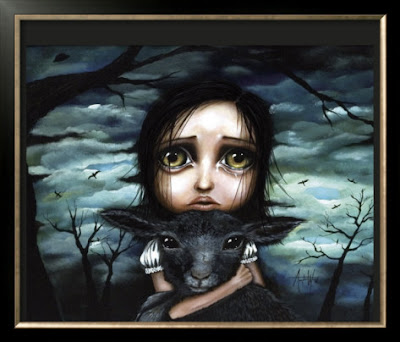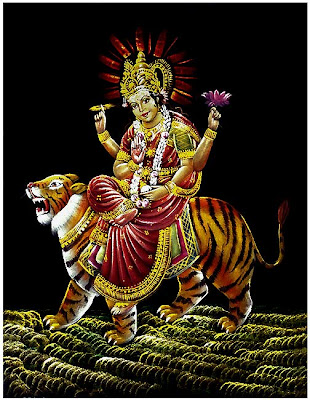One of my friends dislikes velvet paintings so much that he has vowed to buy every one he sees at a yard sale or flea market, just so he can destroy it and take it off the market. I think he must mean the kind featuring children and clowns with large, sad eyes, because would you really destroy a large velvet Elvis? Well, I might, but I know others who would be horrified at the very idea.
Although mostly viewed as a kitsch form of art, black velvet paintings actually have much more venerable origins.
Velvet was invented in Kashmir, on the border between India and Pakistan. The first paintings on velvet likely originated here, and were later introduced to Western Europe by Marco Polo. In the Caucasus, early velvet paintings were religious in nature. Painted by Russian Orthodox priests, they portrayed saints and other figures as icons. Some of these works can still be found today in the collections of the Vatican Museums.
Over the centuries, velvet was painted with small patterns for use in high-end clothing. As with virtually all older forms of art and craft the technique also enjoyed a bit of a resurgence in Victorian times, as a craft for ladies. Firescreens, portraits, upholstery and other forms of painted velvet all appeared in the mid- to late nineteenth century.
American artist Edgar Leeteg is thought to have initiated the modern taste for paintings on velvet. In the mid-1930s, he moved to Tahiti, where he painted semi-clothed Tahitian women on black velvet, as well as religious subjects such as Jesus. His work eventually found its way to a gallery in Hawaii, where his paintings sold for thousands of dollars. Although some compared Leeteg to artists such as Frederick Remington and Paul Gauguin, most viewed his work as kitsch.
Leeteg died in a motorcycle accident in 1953, his body riddled with an antibiotic-resistant strain of venereal disease that had resulted in women publicly warning others away from him. Leeteg probably would have concurred, having once described himself as a "fornicating, gin-soaked dopehead."
 |
| Conch Blower by Edgar Leeteg. Source: http://www.zuckerloft.com/archives/2006/09/ |
The heyday of velvet painting, however, was likely the 1970s. In Ciudad Juárez, Mexico, an expatriate Georgia, U.S.A. farm boy named Doyle Harden created an enormous velvet-painting factory, turning out paintings by the thousands. The factory was run something like an assembly line, with one artist painting one section of a picture, then passing it to the next artist, who would paint another section, and so one. Harden's factory approach is thought to have single-handedly fuelled the American craze for velvet paintings during the 1970s.
Following on the craze for buying ready-made velvet paintings were kits that allowed people to paint their own in a paint-by-numbers format. Popular topics included clowns, cowboys, landscapes, and of course sad-eyed children. I'm pretty sure I painted one of the latter myself when I was little.
Today, velvet paintings are still widely available, particularly in the United States, often with kitsch themes. They often feature iconic figures such as Elvis Presley, Dale Earnhardt, Marilyn Monroe, and Jesus. Other popular subject matter includes Native Americans, cowboys, wolves, nudes, bullfights, as well as more avant garde themes.
 |
| Spock by Bruce White. Source: http://velvetgeek.com/?p=758 |
In recent years, some artists have also revisited the content of vintage velvet paintings to inspire other works. My favourite is Angelina Wrona, who happens to be a local girl, with a gallery in Merrickville, Ontario.
 |
| Clarice by Angelina Wrona, Source: http://www.squidoo.com/angelina-wrona |
So iconic is the notion of velvet painting in pop culture that, from 2005 to 2010, there was an entire museum devoted to the art in Portland, Oregon, called the Velveteria.
 |
| The now-closed Velveteria in Portland, Oregon. Photo: © 2006 Casey Bisson Source: http://tlc.howstuffworks.com/family/portland-city-guide11.htm |
For today's elephant, I wanted to work small. I also thought I should have an elephant with large, sad eyes.
I decided to base my design on my Etch a Sketch elephant and fabric markers elephant, since these struck me as most likely to accommodate sad eyes with tears. Neither of these was based on a photograph, so the pose is probably unrealistic. Elephants don't cry or shed tears as we do, either, so I was taking a fair amount of artistic license here.
For my painting surface, I used a piece of black cotton velveteen measuring approximately 12.5 cm (5 inches) square. To keep my painting surface taut, I put it in a small embroidery hoop. This gave me a canvas of about 10 cm (4 inches) in diameter.
I started by making a faint sketch using a white tailor's chalk pencil. You could also use regular chalk.
Next, I used white bottled acrylic paint to emphasize some of the outlines. I used white because I thought a bit of white underlay would probably make the design pop a bit against the black background.
Next, I added some mauve, blended with a bit of white. I used it mostly full-strength, working it into the fibres to create some shading. I also discovered at this point that, if the paint is the least bit watery, it sucks right into the fabric. Full-strength paint, however, is hard to manipulate on velvet, so it's a bit of a toss-up.
After this, I added blue, then leaf green, then yellow and a hint of red. I mostly layered these colours over one another, to make the colours dance a bit.
To finish up, I added some more white to create additional highlights, working it into the fabric so that it didn't overwhelm the colours. I also added the sad eyes. I didn't really know how to draw eyes with tears, so maybe these should have been a bit more transparent. Oh well.
If you decide to try this, here are a few tips.
1. You can use either acrylic or oils on velvet. I chose acrylics because they're easier to thin, but either works nicely on fabric.
2. The thinner the paint, the more likely it will be to suck into the fabric and not sit on the surface. This can be good if you want to create subtle shading, but will require considerable layering if you want more vibrant colours.
3. Let the background colour do some of the work. I thought about this too late in my painting, and wish I'd left a bit more black near the outlines and in the shadows.
4. If you do layer, use lots of colours you may not think you need. It will give your design depth and life.
5. Be sure to include a few highlights in thicker paint to make your design pop against the dark background.
6. Play with your brushstrokes. I found that I got the most interesting effects if I ground a small amount of paint into the velvet fibres. You can also play with paint thickness: watery paint creates more subtle effects than thick paint, for example.
This took me nearly two hours, which was more time-consuming than I expected it to be. I was very glad I'd decided to work small today.
In the end, I was happy with the way this turned out, but I doubt very much that I'll ever start producing velvet paintings. This would probably be an interesting technique to use in connection with other fibre-based art, however, and I'll probably play with it some more.
I just hope my friend likes this little piece well enough not to want to kill it.
Elephant Lore of the Day
Although there are no elephants today in velvet's home state of Kashmir, the fossil record indicates that the mountain region may once have had a sub-tropical climate in which elephants flourished.
In 2000, Indian geologists unearthed a 50,000-year-old elephant fossil in the state of Jammu and Kashmir. It was unexpectedly discovered in a field of saffron near Srinagar by geology students. The find consisted of a skull measuring 1.5 by 1.2 metres (5 by 4 feet), with complete upper and lower jaws, a broken tusk, and a vertebra.
Similar fossils had been discovered on India's central Gangetic Plain and in the southern Narmada Valley, but this was a first for Kashmir. The find was expected to shed new light on changes in climate and wildlife patterns in Kashmir, and initial research suggests that Kashmir once had a sub-tropical climate—unlike the cooler climate it has today.
 |
| Elephant fossil being unearthed in Kashmir, 2000. It took four days to remove it. Source: http://news.bbc.co.uk/2/hi/south_asia/913788.stm |
To Support Elephant Welfare










No comments:
Post a Comment